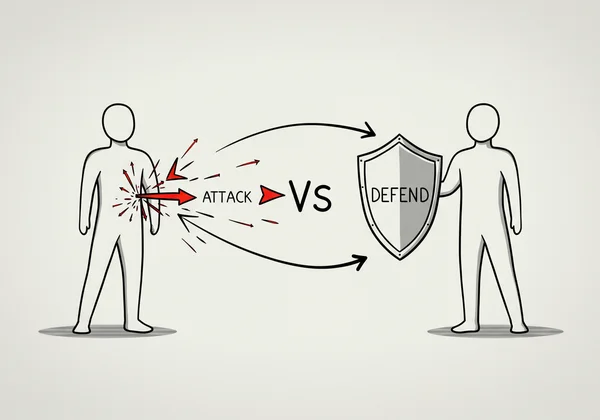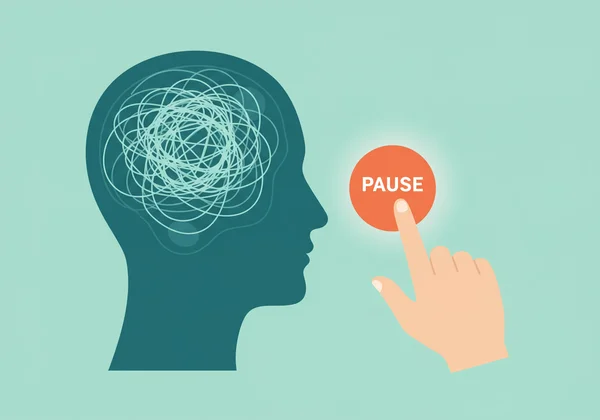Anger Test for Relationships: Learn to Communicate Without Conflict
That heavy, tense silence after an explosive argument. The familiar, sinking feeling of regret that follows a shouting match. If this cycle feels all too common, you're not alone. The pain of seeing anger in relationships chip away at the connection you cherish is real, and it often leaves you asking, "Why am I so angry?" The desire to break this pattern is the first and most crucial step toward change. The good news is that understanding the roots of your anger can pave the way for healthier communication and a much stronger partnership.
This guide is designed to help you navigate that path. It’s not about placing blame; it's about gaining awareness. True change begins with understanding your own emotional landscape. Before you can build better communication habits, you must first understand what you're working with. This is where your journey to self-awareness begins, and a great starting point is to start your self-discovery today.
Why Unchecked Anger Damages Relationships
Anger itself isn't the enemy. It's a natural human emotion, often signaling that a boundary has been crossed or a need isn't being met. However, when anger becomes unchecked, poorly expressed, or the default response to conflict, it can poison the very foundations of a partnership. It moves from being a signal to a destructive force, creating distance where you crave closeness.
The Hidden Impact: Eroding Trust and Intimacy
Trust is the bedrock of any healthy relationship. It’s the feeling of being safe, seen, and secure with your partner. Every outburst, every sarcastic jab, and every cold shoulder acts like a crack in that foundation. When one partner frequently expresses anger through yelling or passive-aggression, the other learns to be guarded. This creates an environment of emotional instability, where it’s no longer safe to be vulnerable. Over time, this erosion of trust and intimacy can leave both partners feeling lonely and disconnected, even when they're in the same room.

The Attack-Defend Cycle: A Communication Dead End
One of the most common and destructive communication patterns is the attack-defend cycle. It starts when one person expresses their frustration as an attack ("You never listen to me!"). The other person, feeling cornered, immediately jumps to defensiveness ("Yes, I do! You're the one who's always interrupting!"). From this point on, the conversation is no longer about the original issue. It becomes a battle of wills, with each person trying to prove they are right and the other is wrong. This cycle solves nothing and only reinforces feelings of resentment and misunderstanding, leading to a communication dead end.

Recognizing the Signs in Yourself and Your Partner
Problematic anger doesn't always look like a shouting match. It can be subtle, creeping into daily interactions in ways that are hard to pinpoint but leave a trail of hurt. Recognizing these signs is a vital step toward change. Do you find yourself or your partner engaging in constant criticism, keeping score of past wrongs, giving the silent treatment, or making excuses for outbursts? Do you feel like you have to "walk on eggshells" to avoid setting your partner off? These are all indicators that anger is negatively impacting your relationship. An objective anger assessment test can help you see these patterns more clearly.
How to Stop Yelling at Your Partner: 7 Practical Steps
Breaking the cycle of anger and yelling is a skill that can be learned. It requires patience, commitment, and a willingness to look inward before you lash out. These seven practical steps can serve as your roadmap to more peaceful and effective communication, but they are most effective when you understand your unique emotional profile.
Step 1: Identify Your Personal Anger Triggers
Anger is often called a "secondary emotion" because it usually masks deeper, more vulnerable feelings like hurt, fear, disrespect, or helplessness. Your first and most powerful step is to understand what's really setting you off. Is it feeling ignored when you’re talking? Does a certain tone of voice make you feel disrespected? These are your personal triggers. The most effective way to begin this process is to Identify Your Personal Anger Triggers with a structured tool designed to explore your emotional responses. A scientifically-backed test can reveal the patterns—the frequency, intensity, and specific triggers—that you might not even be aware of.
Step 2: Use "I Feel" Statements to Own Your Emotions
Blaming language instantly puts your partner on the defensive. Shifting from "You" statements to "I" statements can transform an accusation into an expression of your feelings. Instead of saying, "You never help around the house," try, "I feel overwhelmed and unsupported when the chores pile up." This simple change invites empathy instead of an argument. It frames the issue as your experience, which is undeniable, rather than an attack on their character. This is a core part of healthy emotional expression.
Step 3: Master the "Time-Out" to De-escalate
When you feel your anger rising, your body enters "fight or flight" mode, and rational thinking goes out the window. The best thing you can do in that moment is to take a time-out. Agree on a neutral phrase with your partner beforehand, like "I need a 20-minute break" or simply "Pause." This isn't about storming off; it’s a strategic retreat to calm your nervous system. During the break, focus on your breathing or go for a short walk. Return to the conversation only when you feel you can communicate calmly. This single act of de-escalation can prevent immense damage.

Step 4: Listen to Understand, Not Just to Respond
In a heated argument, we often listen only to find flaws in our partner's logic so we can form our rebuttal. This isn’t listening; it's reloading. Active listening means giving your partner your full attention. Put your phone down, make eye contact, and try to truly hear the emotion behind their words. You can show you're listening by summarizing what you heard ("So, it sounds like you felt hurt when I was late") before sharing your perspective. This validates their feelings and makes them feel heard, which is often what people want most.
Step 5: Solve the Problem, Don't Win the Fight
Shift your mindset from "me vs. you" to "us vs. the problem." The goal of a healthy conflict is not to determine a winner and a loser, but to find a resolution that works for both of you. Frame the issue as a shared challenge. For example, "How can we work together to make sure we both feel respected when we discuss finances?" This collaborative approach fosters teamwork and reinforces that you are on the same side, strengthening your bond through conflict resolution.
Step 6: Apologize Meaningfully
A sincere apology is a powerful tool for rebuilding trust. A real apology has three parts: acknowledging what you did wrong ("I’m sorry I raised my voice"), recognizing the impact it had on your partner ("I know that must have been hurtful and scary"), and stating how you will act differently in the future ("I'm working on taking a time-out before I get to that point"). Avoid non-apologies like "I'm sorry you feel that way," as they shift the blame.
Step 7: Acknowledge Progress, Not Perfection
Changing long-standing emotional habits takes time. There will be setbacks. The key is to acknowledge and celebrate the small wins. Did you manage to take a time-out before yelling? Did you use an "I feel" statement during a tough conversation? Acknowledge that progress. Be kind to yourself and your partner. This journey is about gradual improvement, not overnight perfection. This emotional regulation skill builds resilience in your relationship.
Your Journey to a Peaceful Partnership Starts Now
Learning to manage anger in your relationship is one of the most powerful gifts you can give your partner—and yourself. The steps outlined here provide a powerful framework for change, but they all depend on one foundational element: self-awareness. You can't change what you don't understand. Learning to communicate without conflict starts by understanding your personal anger profile—its unique patterns, its hidden triggers, and its true intensity.
While these strategies are effective, they work best when you have a clear picture of your starting point. Ready to understand the 'why' behind your anger and take the first concrete step toward healing your relationship? Take our free, scientifically-backed Anger Test to gain the personal insights you need to build a more peaceful and loving partnership today.

Frequently Asked Questions About Relationship Anger
How do I know if I have anger problems?
You might have anger problems if your anger feels uncontrollable, happens very frequently, seems disproportionate to the situation, or is causing negative consequences in your relationships, work, or health. If you find that others are afraid of your temper or you often feel regret after an angry episode, it's a strong sign that you could benefit from taking a closer look. An online anger test can provide an objective measure of your anger patterns.
Can an online anger test really help my relationship?
Yes, it can be an incredibly helpful first step. An anger issues test provides a private, non-judgmental space to explore your emotions. The results can give you a personalized snapshot of your anger triggers, frequency, and expression styles. This self-awareness is the foundation for meaningful conversations with your partner and for applying the communication techniques discussed in this article more effectively.
What's the difference between healthy anger and a problem?
Healthy anger is an appropriate, managed response to a genuine grievance. It's expressed assertively, not aggressively, and leads to resolution. Problematic anger, on the other hand, is often disproportionate, uncontrolled, and destructive. It creates fear, damages trust, and cycles without resolution. The key difference lies in the expression and the outcome: healthy anger builds understanding, while problematic anger tears it down. To see where you fall on this spectrum, take our free test.
Disclaimer: Please note that the information in this article and our test are for educational and self-exploration purposes only. They are not a substitute for professional medical advice, diagnosis, or therapy. If you are in a crisis or feel your anger is a danger to yourself or others, please contact a qualified mental health professional or a local emergency service.